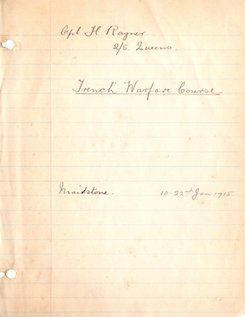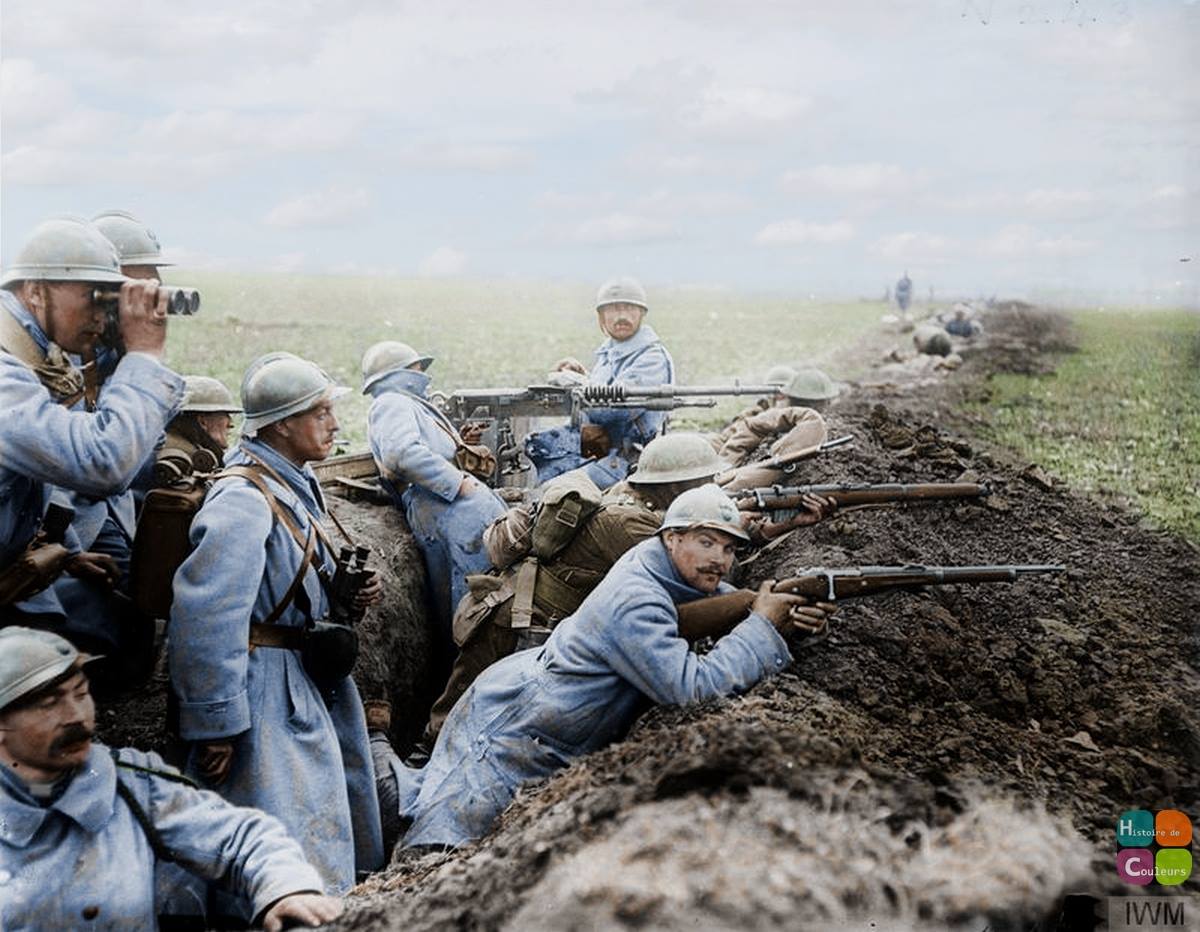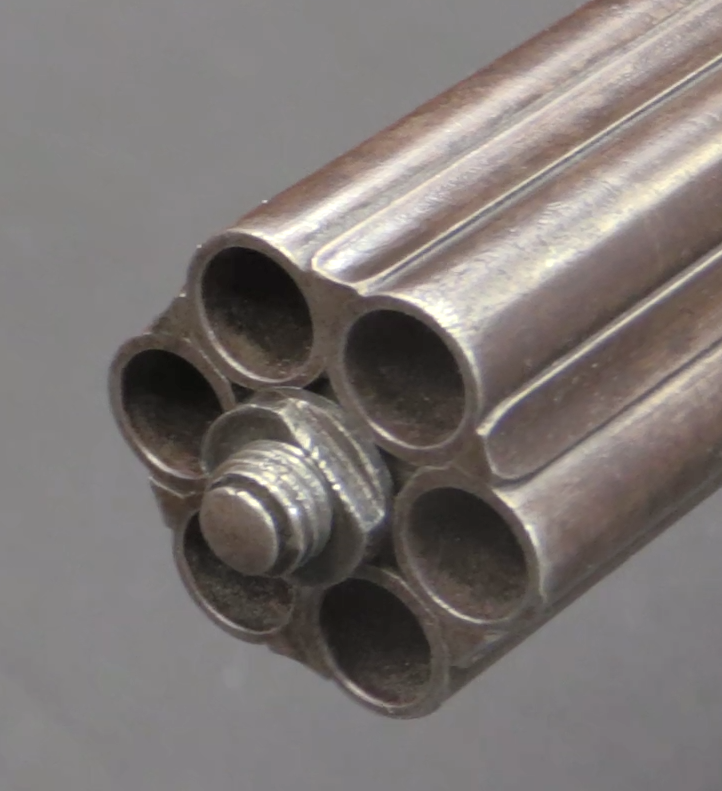The SMLE No1 Mk3 was the iconic British infantry rifle of World War 1, but not the final evolution of the Lee Enfield design. By World War 2 it had been replaced by the new No4 Mk1 Lee Enfield, and this is the story of the interim models.
At the end of WW1, the British recognized several areas where the SMLE could be improved: a heavier barrel, a lighter bayonet, and aperture sights. This led to the development of the No1 Mk5 rifle (the Mk4 being a designation for a .22 rimfire training variation), with 20,000 examples made for troop trials in the mid 1920s. The Mk5 was well received by troops, with its rear-mounted aperture sight being seen as a substantial improvement over the previous tangent notch sight. However, experimentation continued and by 1926 prototypes of a Mk6 rifle were being made.
In 1929 a series of 1000 No1 Mk6 rifles was put into production, which would fit a new style of short and light spike bayonet as well as an improved type of aperture sight. They also featured a very distinctive large area of deep square checkering on the hand guard, intended to improve one’s grip on the rifle during bayonet drill. These rifles were nearly the same as what was ultimately adopted as the new No4 Mk1 rifle – so much so that in 1931 that designation was applied to the rifles and a batch of 2500 more made for trials. These trials rifles were mostly issued out to troops in the aftermath of Dunkirk, making them very scarce to find today, as most did not survive the war. Those that did will sport a new serial number with an “A” suffix to indicate their non-standard parts (in comparison to the production model No4 Mk1. Today were will look at the progressive development of a pre-prototype Mk6, Mk6 rifle number 1, a Mk6 trials rifle, and one of those 2500 trials No4 Mk1 rifles.




“(the Mk4 being a designation for a .22 rimfire training variation)”
Sorry Ian, but the Mk.4 designation was actually Mk.4(Cond) for earlier patterns converted to Mk.3 or 3* configuration.
The .22 trainers were No.2’s (and another mishmash of odd confusing designations like Pattern 14 which had nothing to do with the .303 P14 rifle).
I owned a P-17 long ago, it was an Eddystone, and had been one of the Home Guard rifles in 30-06 with the red paint on the stock. It seemed like a much better rifle to me than the SMLE. I’ve always wondered why the British never put it into production and continued with the SMLE types instead
“better” is never an absolute
The logical response to assertions of better, are the questions of; Better for whom, for whatpurpose, when, how and why?
The lobby behind the P14 appears to have been the British NRA, who to this day seem to view the world through the very narrow lens that people should be shooting targets with bolt action rifles at Bisley.
And also the carping and bitching by people who wanted their gun adopted, so they could be paid royalties. The same thing was seen in 1892 and 1893, following the united state ordnance Committee, recommendation of the Krag and Jorgensen – a “foreign” rifle.
Spurred on by successes on the target ranges with the 7mm Ross, the British military establishment, seem to have taken Teddy Roosevelt’s example (arguably a gross mistake, breeding a Krag with a model 93 Mauser, and chambering it for a heavy kicking, barrel heating but otherwise under performing round) and tried to create a state sector solution.
The P14 contractors were slow to tool up, quality was dubious (eg brittleness of Eddystone production) the rifle was too long for convenient use in trenches, and compared to the Lee, it was more sensitive to mud, had a smaller magazine capacity, was slower to aim and operate…
P14s were therefore used to fill second line roles, in order to free lees up for front line use. As soon as those needs were fulfilled, the disappointing contracts for manufacture were cancelled.
Incidentally, arguments (usually from America) about “strength” are largely propaganda. “Strength” for what? Commercial Lee’s were available chambered and proofed for .375/303 Westley Richards. It has roughly the same case capacity as the 03/06 and the European x64mm cases, and was factory loaded to higher velocity in each bullet weight than the .300 Holland and Holland belted magnum.
“Better for whom, for what”
http://www.staffshomeguard.co.uk/J16-11EnfieldP14.htm states that:
NOTES ON THE P.14 RIFLE
(…)
Performance.
Owing to its long sight base, substantial barrel and aperture backsight, it is extremely accurate.
It is no so easy to manipulate in rapid fire as the S.M.L.E. This is partly due to the longer butt and wider stock where it is gripped by the left hand.
Which is exactly what the NRA hierarchy saw as the be all and end all of what a rifle should be, and what soldiers should be doing on the battlefield – the same as the NRA members filled their leisure time with at Bisley. That view continued at least up until 1988, with the British NRA stating publicly that (in their opinion) there was no good reason why anyone should have a semi auto rifle.
The P14 inherited the same foreward angled rear guard screw from the 01, 02 and 03 springfields, that the Springfields had inherited from the Krag and Jorgensen (along with most of the rest of the rear half of the Krag and Jorgensen that was carried over into the Springfield). So neither of them is particularly good at maintaining stable bedding or zero – compared to virtually anything.
The SMLE had been pushed through by an unholy alliance of “Indians”- senior officers who had served on the north west frontier, and who appreciated the ability of their troops to engage fleeting targets of opportunity, skirmish and generally to use their initiative,
And cavalry, who after disastrous under performance in Sudan, were desperate to appear relevant, and to be at least the battlefield equal of infantry.
The SMLE was short and lightened, the barrel being slimmer than on the earlier Lee Metford and long Lee Enfield, in order to reduce weight and increase handleability for snAp shooting at hill tribesmen or Afrikaans, popping up from behind rocks.
– this was of course anathema to the NRA.
The cut off was (and had been since the adoption of theLee Metford) a sop to the traditionalists, who saw a repeater as a threat to the order discipline and the position of Ruperts within the army.
These were people who had learned their art in the days of black powder, and belived in squares of men standing shoulder to shoulder, and firing volleys at targets selected by their Rupert. To them, random fire would obscure the Rupert’s view with smoke, and drown out his commands – leading to loss of respect and chaos, and of course waste ammunition, that had to be transported along long supply lines.
The No4 increased barrel weight (having saved weight by eliminating the nose cap). And, increased sight radius.
It’s interesting to see how late in the development, the receiver was beefed up – “strength” was clearly not a pressing issue! It would be interesting to read the files from that time to see what the actual reason for the beef up were.
Where the No 1 mkiii was difficult to bed, due to its lightened barrel and heavy nose cap (it was never intended to be a target rifle), the No4 with its heavier barrel and slightly stiffer receiver Will bed and keep its bedding as well as any other military rifle, and better than most. A friend in South Africa has his scoped No4 shooting consistent .4 minute groups with handloads, with its seventy whatever year old military barrel.
For some odd reason the only rifle as common in the rear-window gun rack of trucks on the town square when I was a kid (west central Missouri, late 1960s) as a lever action .30-30 was a “Brit .303.” Not sure I’ve ever even seen a Pattern 1914 (some trigger time on both MILSPEC-restored and heavily customized 1917s, which are fine rifles) but my own personal not-worth-arguing-over opinion is that the No 1 Mk III is a damn good rifle and a No. 4 is about as good as it gets. Just an amazingly ergonomic rifle with a butter-smooth action… I’ve never shot a rifle that could put 10 rounds so close so fast offhand (on a piece of typing paper at 75 yards in 8 seconds or so, back when that great Greek surplus ammo was so cheap and I could afford to practice a lot) as my Irish-surplus No. 4. Just wonderful rifles; my .303 won several bowling-pin matches against much more modern ARs and threw the pins a lot farther than the .223s. And I’ve never had to track a deer I shot with a .303 (full-length military stock, peep sight, and all) loaded with American soft-point ammo.
“.223s”
It was never designed to outperform .303 British cartridge, moreover there is more than half of century between adoptions of both. Thus .303 should be rather compared with 7.65 Argentine Mauser or 7.62x54R than .223.
“Which is exactly what the NRA hierarchy saw as the be all and end all of what a rifle should be, and what soldiers should be doing on the battlefield – the same as the NRA members filled their leisure time with at Bisley”
But it must noted that before First World War, also in other countries there was believing in that long range rifle fire would be useful, take for example 7×57 Meunier:
http://www.municion.org/7mm/7x57Meunier.htm
though French forces want to adopt self-loading rifle
“That view continued at least up until 1988, with the British NRA stating publicly that (in their opinion) there was no good reason why anyone should have a semi auto rifle.”
Ignoring potential enemy equipment is unwise, speaking mildly.
French ammunition in the world wars was amazing. Crappy texts like Cartridges of the world and the Smith’s propaganda works give no indication of just how good it was.
8mm Lebel Balle D, despite modest muzzle velocity (2,300 fps, so about .30-30 velocity) had both the original .30-06 and M2, beaten on all counts from where the .30-06 is popularly claimed to come into it’s own :600 yards
Balle D has less drop at 1,000 yards and there’s absolutely no comparison beyond 1,000 yards.
The .303mk vii bullet, even if it is fired at.30_30 velocities (just to give the .30-06 a chance) overtakes the .30-06 at about 800 yards and stays ahead.
Not so important for ordinary rifle fire, but, as Julian Hatcher relates in “Hatcher’s notebook” it was a big disappointment to American machinegunners when they received new Brownings chambered for.30-06, to discover that they had lost about one third of the range that they could lay down a barrage over, compared to the 8mm Hotchkiss and .303 Vickers guns that the Brownings replaced.
“French ammunition in the world wars was amazing.”
As side note G1 in G1 coefficient is for Commission d’Experience de Gâvre.
“new Brownings chambered for.30-06, to discover that they had lost about one third of the range”
That explain why Norway and Sweden adopted Browning-designed machine gun, but designed own special cartridges:
Norway used 7,92 × 61 mm for Colt mitraljøse m/29
Sweden used 8 × 63 mm patron m/32 for Kulspruta m/36
.30-06 M1 ball, with a 175-180 ish grain sharper pointed boat tail bullet, based on Swiss designed target shooting bullets, had the long range performance and less wind drift, but it overshot the danger areas around ranges, kicked harder, and was heavier to carry.
Marine corps snipers liked selected batches of it, but beyond that, there doesn’t seem to have been much made or used.
.303 Mk viiiz was ultimately based on the same Swiss designed bullet, but, in the form that that bullet had been commercially copied by Kynoch.
Interestingly, the 7.5mm Swiss round has the same capacity and working pressure as .30-06, not that Barnes COTW will say much about that. So performance will be about the same as .30-06 M1 ball.
The big heavy bulleted 8mm machinegun Cartridges seem to have popped up in places where the infantry rifle cartridge was a nice, light recoiling 6.5mm: Norway, Sweden, Italy…
German military rifle bullets went from 150 grains in WWI to around the 198 grains in WWII.
How to get a higher payload out to longer ranges.
“The big heavy bulleted 8mm machinegun Cartridges seem to have popped up in places where the infantry rifle cartridge was a nice, light recoiling 6.5mm: Norway, Sweden, Italy…”
There was experimental 9×66 cartridges by MAS made in early 1930s, query in municion: http://www.municion.org/French/9x66Mas.htm
but it don’t explain why or for who they was made. It uses ~9,3 mm bullet but of unknown mass and velocity. Available photo show cartridge with link, which suggest it was made for belt-fed weapon.
“I’ve always wondered why the British never put it into production and continued with the SMLE types instead”
Textbook of Small-Arms 1929 explains it perfectly. Basically performance in WW1 vindicated and validated the SMLE, despite the “Bisley school of thought” trying desperately to push a Mauser-type pre-war. And it’s amazing how much of the propaganda from more than 100 years ago is still common currency today.
With millions of both SMLE’s and P14’s on hand at the end of WW1, in the 20’s the War Department could have pursued either design quite easily (and both were as “invented here” as each other, so there’s no jingoism involved) – they chose to go back to the SMLE platform and move forward with that through the No.1 Mk.V (my personal favourite), Mk. VI and then onto the No.4.
“It’s interesting to see how late in the development, the receiver was beefed up – “strength” was clearly not a pressing issue! It would be interesting to read the files from that time to see what the actual reason for the beef up were.”
Manufacturing convenience – removing less metal, and removing it with straight lines rather than the smooth curve on the earlier production models. Even the No.1 Mk.VI had a lot more material removed than the later No.4, from the left sidewall in particular. It’s certainly not beefed up for strength – the thinnest cross-section in stress is the bolt body in any case, and that’s got massively less cross-sectional area than the receiver walls. Thickening the receiver walls “for strength” when it’s the bolt that’s the most highly stressed part would be a bit like strengthening the structure of an aerial walkway when it’s the bolts holding it on that are the weak point 🙂
I may, MAY mind you, have stumbled across a sporterized MK.VI at a local gun shop. It has a synthetic stock that has the cut off plate removed and covered by the synthetic stock.
I have my doubts but I’ve had multiple people tell me it is a MK.VI, or at the very least the receiver originates from one. Is there any way I can confirm this with anyone?
I once had the opertunity of shooting a sporterised mkm4 in 303 this guy I worked with at the time was trying to sale this rifle the cut down stock wasn’t so bad it was the cut checkering on the stock that some fool did with a pocket knife that turned me away !But man could I shoot it we were above the money river shooting Pepsi bottles thrown into the river from a very high vantage point,Now I know this was a stupid thing to do but we did it back in the seventies !point is I honestly remember never missing a shot from about 100 yds these bottles floating down the river ugly as it was this rifle was easy for me to shoot extremely good with I was no amature at shooting I had many rifles at the time and could shoot with the best marksmen but this old smle was deadly in my hands ,The forman of our crew of road workers was so impressed with my shooting he bought the gun from the guy ,said to me well if you can hit that good with it I should be able too as well ,I knew him up untill his death two years ago and indeed got quite a lot of deer with it even though he had lots of high dollar shooters bottom line is I know the smle rifle is ugly weak very different but I’ll challenge you to find a more off hand shooting machine that my friend is why the limies liked em!